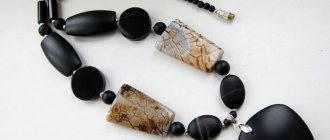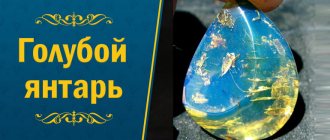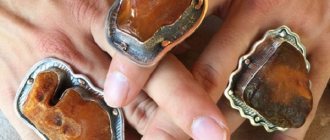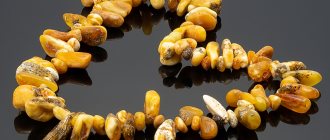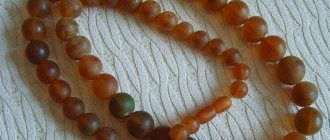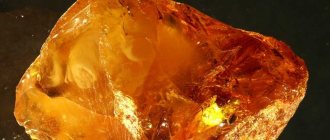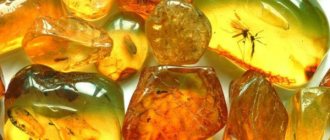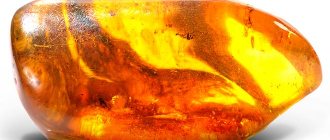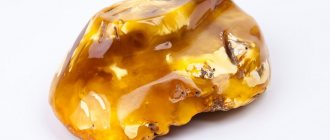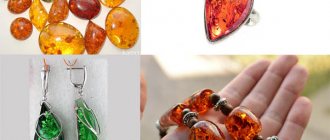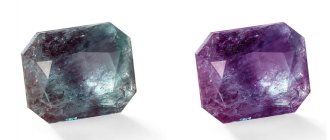Amber is the frozen and fossilized resin of ancient trees. The color of amber is extremely rich: yellow, orange, brown, milky white, green, various shades of blue, sometimes almost black. The best gemstone is the one that has the color of wax or a transparent red tint. Particularly valuable are pieces of amber interspersed with air, water, insects, and lizards. Amber is called “the gold of the Baltic” because the largest deposits of this gem are located on the coast of the Baltic Sea. A teardrop-shaped gem that looks like frozen tears is often found in the Dominican Republic.
Amber is a high-molecular compound of organic acids. Nitrogen, silicon, sulfur, iron and aluminum may be present as impurities.
Interesting Facts:
- The elixir of immortality offered to Pope Boniface VIII by his chief personal physician included amber.
- In ancient times, it was believed that if you put a piece of amber on the chest of a sleeping wife, she would tell all her bad deeds.
- Martin Luther always carried a piece of this mineral in his pocket to prevent stones from forming in his kidneys.
What are the colors of amber?
Amber is a stone with a rich range of colors. Experts count from 200 to 400 different shades of this gem.
In all the variety of colors, yellow, golden and orange shades undoubtedly lead. The epithet “sunny” amber received precisely for the abundance of warm, warming shades.
Amber of cherry and red colors - the color of "dragon's blood" - was especially popular in Japan and China. There, only members of the ruling dynasty were allowed to wear large stones, whose brilliance and color resembled rubies. How did amber of such a rare color appear? It turns out that the blood-red color of the gem is due to forest fires: due to severe overheating, the pieces of amber changed their color.
White amber only seems so. In fact, milky amber is a yellow mineral that is abundantly filled with microscopic particles of moisture and air. They “whitened” the original shade. In our country, milky-white amber is called “soapy,” but in the West, the ivory-colored mineral is called “royal.”
The color of rare blue amber has shades from cornflower blue to pale blue. At one time it was believed that the unusual shade was due to small inclusions of vivianite, but recent research has refuted this version. It turned out that this color is caused by microscopic voids inside the gem, which, by refracting and scattering light, create a special optical effect.
Green amber got its unusual color thanks to particles of plants and soil that got into the resin.
Black amber is better known today as jet. Back to contents
Description of the stone
In Ancient China and Japan, red amber was considered the blood of a mythical animal - the dragon. In Ancient Greece there was a legend about Phaeton. The mother and sisters, mourning the death of the young man from the lightning of Zeus, shed bloody tears, which, falling, turned into red stone.
The gem was compared to blood. It is the blood-red color that is characteristic of this type of amber. Outwardly it looks like a ruby. The samples with a transparent structure were recognized as the best.
The stone acquired its unique color due to the fact that the resin-resin did not immediately fall into the soil, but solidified on the bark and remained there for some time under the influence of winds and the environment. Getting into the ground, it combined with zinc, iron, magnesium, so that after millions of years it appeared to the world in a scarlet-crimson or brownish appearance.
Deposits of red gemstones are found in Russia, Ukraine, Myanmar, the Dominican Republic, Italy, Hungary, Japan, Australia and Africa. Moreover, in terms of rarity it ranks second after blue Dominican amber, and in value it is second only to white royal amber.
View this post on Instagram
Posted by Yantar Baltic (@amber.diver.39) Feb 22, 2022 at 4:27 PST
Types of amber
Amber succinite
According to physical and chemical properties, amber is divided into the following types:
- succinite - a stone with a high level of succinic acid in its composition, has yellow-brown tints and is divided into subtypes: landscape, bastard, batter, flom and knoken;
- gedanite – yellow, extremely fragile gem;
- bokkerite is an opaque stone of reddish shades, with a high level of hardness and density;
- Glessite is an opaque brown mineral, devoid of foreign impurities;
- kissellite – yellow-green, olive-colored crystals;
- stantienite - opaque gems of a dark brown, almost black color, characterized by increased fragility;
- kranzite – crystals that have not passed the maturity stage;
- shraufite is a red or yellow-red mineral.
Physical and chemical properties
Amber is a hardened fossil resin. The result was a stone that was not too hard and brittle. The form of birth is not crystals, like many gems, since it is an amorphous framework polymer.
The chemical composition of pure amber is:
- Carbon – 79%.
- Hydrogen – about 11%.
- Oxygen – about 9%.
The presence of various impurities determines the color. There is no pleochroism, no birefringence and no dispersion, but luminescence is present. When rubbed, it becomes electrified, thereby receiving a negative charge. Amber is very flammable, as it ignites even from a burning match. When exposed to open air, it oxidizes (“agees”), changing color and chemical composition, while becoming more fragile.
| Formula | C10H16O+(H2S) |
| Color | Over 300 shades, the main ones are yellow, golden, cognac, orange, orange-red, milky white, cloudy colorless, green, brown and black. There is no pleochroism. |
| Probable impurities | Many different ones, such as silicon, aluminum, calcium, iron and others. |
| Shine | More often resin and glass, less often matte and greasy |
| Hardness | 2-2,5 |
| Transparency | Any – from completely transparent to completely opaque |
| Cleavage | Absent |
| Strength | Fragile |
| Kink | More often conchoidal, less often viscous (brittle when aging) |
| Density | More often 1.05-1.09, less often up to 1.3 g/cm3 |
| Specific gravity | 1,0-1,1 |
| Melting temperature | Depending on the type 520-550 degrees, when heated to 1000 degrees it evaporates |
| Solubility | Insoluble in water (softens in boiling water), partially soluble in alcohol, ether, chloroform and linseed oil, completely decomposed by hot concentrated nitric acid. |
| singonia | Absent |
| Refractive index | 1,539-1,545 |
| Birefringence and dispersion | Not observed |
| Luminescence | Present – from white-blue to yellow-green |
How amber is mined
The most primitive and ancient method of extracting amber is manual collection from shallows and beaches where the gem has been washed up by the sea.
In ancient and medieval times, this method was the main one. In the 14th century, another, but no less unpretentious method of collecting began to spread - catching algae with amber entangled in it with large nets with a long handle.
Later, scooping up amber from the bottom of the sea began to be practiced. People were helped in this by devices such as pliers, scrapers and hooks. This procedure was usually carried out from a boat, always in calm weather.
The next method was harrowing the coastal soil. The loosened soil was mixed with water and amber emerged to the surface of the soil, which, again, was collected by hand. This method dates back to the mid-16th century.
Digging for amber began in the mid-17th century, but this method of extraction did not last long - at the end of the 19th century, underground collection became unprofitable.
The most productive was the collection of gems using open-pit mines. This method appeared in the first half of the 19th century. Back to contents
Where is white amber mined?
Nuggets began to be mined in ancient times. Even then their uniqueness and value were known. The highest quality and largest gems are found in the Baltic deposits. They produce over 80% of the total amount of royal amber. The world's largest open-pit mine is located in Kaliningrad. This mineral is mined by open-pit mining, not by extracting it from a mine, but by washing it in water. Sometimes there are very large specimens that have no analogues in the world.
There are smaller deposits in Poland, but no development is being carried out there, since the deposits are located at great depths, and their development requires large material investments.
Having conducted research on the mineral, scientists have proven that amber treatment practiced by traditional healers has a scientific basis. The gem contains a lot of succinic acid. It is a biostimulant that has a beneficial effect on the nervous system and the thyroid gland. In case of stress and outbursts of rage, amber calms the nerves, which in this case is recommended to be worn in the form of bracelets on the hands or beads on the neck.
The stone protects the health of the mother and the unborn baby, so it is recommended to wear it during pregnancy. White amber protects from damage and the evil eye, fills with vitality and energy.
Place of Birth
Russia is considered the main supplier of amber on the world market. About 90% of the stone is mined in the Kaliningrad region alone. Less significant deposits are concentrated in Siberia, the Urals and Sakhalin.
Lithuania is famous for its high quality amber samples. In Ukraine, the mineral is mined in the Volyn, Kyiv, Zhytomyr and Rivne regions.
Other most famous deposits of sunstone are located in Indonesia, the Dominican Republic, Mexico, Myanmar, North America, Italy and Romania.
How much can amber cost?
Amber prices are based on four factors:
- The cost of a gem as a raw material.
- Processing depth. During processing, amber loses weight. During deep processing, most of the gem goes to waste. The smaller the amount of raw materials goes to waste, the lower the cost of the product.
- Quality of the stone. Landscape amber is considered one of the most expensive, as well as amber containing inclusions - the remains of plants, insects, and reptiles.
- The artistic value of the product. The less effort the artist spends on making the jewelry, the cheaper it is, accordingly.
The cost of rare varieties of high-quality stone ranges from $20-100 per 1 gram.
The most common yellow colored gems on the stone market cost $5-15 per gram.
The price of 1 gram of red, blue and green crystals can be several hundred dollars.
Prices for white amber
The cost of nuggets and jewelry made from this stone depends on the size of the stone, its transparency and purity, and the presence of inclusions. Very large specimens are exhibits in museums, while smaller nuggets are used in jewelry. The cost of one gram of royal amber can reach up to $100. A medium-sized nugget costs at least 100 USD. e., and larger minerals are estimated at hundreds of conventional units. Royal amber beads are sometimes put up at auctions, and their cost reaches 1.5 thousand dollars.
White amber is an amazingly beautiful and rare stone. Many ladies would like to become the owner of such a luxurious piece of jewelry, but due to its high price, not everyone can realize their dream.
Magical properties of amber
Amber is considered a symbol of joy and happiness, health and longevity. The magical properties of this gem are as varied as its healing properties. Since ancient times, amber has been used as a powerful amulet and talisman.
This gem is a source of optimism, creativity and faith. Amber will enhance intuition, bring good luck, peace and joy. The mineral will help transform plans into concrete actions, give good spirits, and maintain health. Amber is called the magic resin of the forest. It is believed that with its mysterious shine, this stone is able to clarify thoughts and contribute to the implementation of plans.
A pregnant woman wearing amber is guaranteed to preserve the fetus and have an easy, successful birth. Nursing mothers who have this gem will develop a kind and cheerful character in their child.
Amber is a symbol of spiritual connection. Some varieties of the mineral are used in religious ceremonies, as they burn well and emit a pleasant smell - incense. In the past, newborn babies and newlyweds were fumigated with this smoke of burning amber. It was believed that this would bring them happiness.
Evil spirits can be scared away by a piece of raw amber lying at the head. Several items made from this gem will protect the house from lightning and fire.
Amber is recommended to be worn by people prone to suicide and prolonged depression. Back to contents
Medicinal properties
Since ancient times, it was believed that there were practically no diseases that amber could not cure. Today this gem is very actively used in medical practice. Amber helps in the treatment of sore throats, headaches, toothaches and many other ailments. The gem has an effect on the spleen, improves the activity of the heart, and softens the effects of pressure changes. Amber has bactericidal properties. Its ability to prevent the process of destruction of red blood cells (hemolysis) is noted.
Amber crumbs, as well as its salts, are used to make medicinal preparations. In some countries, amber tincture is used as a remedy for diseases of the respiratory tract and throat, and colds.
Amber containing iodine is useful to wear in beads for the prevention or treatment of thyroid diseases. The gem improves the functioning of the digestive system. Succinic acid is used as an anti-inflammatory, stimulating, anti-stress and anti-toxic agent. It is believed that a gem worn around the neck, acting on the carotid arteries, will cleanse the body of toxins.
Amber mouthpiece
Doctors have noticed that an amber mouthpiece reduces the risk of cancer in adherents of the bad habit. In general, amber therapy methods and techniques are used in oncology: this slows down the growth of tumors.
Amber will help with varicose veins and joint diseases. It will relieve inflammation and restore the functioning of venous valves. The gem will help with magnetic storms and improve vision. When exposed to incense, cough and asthma disappeared.
Amber plates are rubbed on the temples for headaches. The mineral helps improve metabolism.
If you lubricate your teeth with crushed amber, they will become shiny, white and stronger. Children who are teething should be given a piece of this gem to chew on. Back to contents
Who is suitable according to the horoscope?
The ruling planet of the stone is the Sun, so it is most suitable for fire signs - Sagittarius, Leo, Aries. The mineral will have a positive effect on all zodiac representatives except Taurus. Of course, wearing amber jewelry will not harm them, but it will not bring any benefit either. The distribution by zodiac is relative, because amber is able to find its owner on its own. For people of the element of Fire, the gem enhances temperament, protects against negative energy, and helps to find the meaning of life. Signs of Water and Air can wear white amber jewelry and use it to treat diseases. Representatives of the Earth should choose other amulets, since this mineral can make the owners lazy, apathetic and indifferent to what is happening.
Storage and care rules
Amber needs careful care.
The following must not be allowed:
- storing stone under conditions of sudden temperature changes;
- prolonged exposure to sunlight (the stone's stay under the sun should not exceed 10-15 minutes);
- dirt and grease, otherwise stains will remain on the surface of the gem;
- contact with perfumes, cosmetics and chemicals, from which the stone can not only become cloudy, but also crack;
- keeping the mineral in a humid environment for a long time so that it does not swell;
- keeping amber near heating devices, as it can dry out;
- any mechanical impact, since some types of stone are especially fragile.
Clean the stone from dirt very carefully. To do this, place it in salted water for 10-15 minutes, after which it is carefully washed in clean water and wiped dry with a flannel napkin.
How to distinguish an original from a fake?
Amber jewelry
Some varieties of amber are especially valued by jewelers, so they try to imitate them and pass them off as real stones. For this, rosin, burmite, epoxy or acrylic resin, mastic, incense, glass, amber varnish and other substances are used. Also on the stone market you can find specimens made from pressed amber.
To distinguish real amber from fake, you should pay attention to the following signs:
- the luminescence effect of a real stone, when it begins to glow from within when exposed to sunlight;
- in salt water, real amber floats to the surface;
- if a stone of natural origin is heated, it will emit the smell of pine needles;
- The natural mineral attracts hair and threads after friction.
Also on the stone market you can find specimens made from pressed amber. Despite their external similarity to solid stone, they are a little cheaper.
Amber and zodiac signs
The ruling planet of amber is the Sun. This gem is more suitable for representatives of fire signs: Leo, Aries and Sagittarius. Their mineral will feed with solar energy, which will contribute to the development of potential, success and prosperity.
Amber suits almost all zodiac signs. The exception is Taurus - this zodiac sign is, as it were, blocked from the influence of the gem. In addition, amber can irritate representatives of this sign and distract from what is important. Amber will protect other Earth signs (Virgo and Capricorn) from ill-wishers, dangers and adversity.
Amber will attract luck and fortune to the signs of the zodiac of the air element (Gemini, Libra and Aquarius), which will have a beneficial effect on their financial well-being.
The stone has a dual effect on representatives of the Water Element (Cancer, Scorpio and Pisces). It can either bring a good mood and bright impressions into their lives, or drive them into a state of apathy and laziness.
Amber should never be worn in silver.
The metals of this gem are only copper and gold. Back to contents
Origin and its formation
In ancient times, the mineral was treated differently. In some states it was valued and used to decorate the home, while in others it was used only as a room fragrance. To do this, in ancient Rome the gem was melted. In Eastern countries, the stone was revered; milky amber enjoyed special respect. It was used in the form of decorations and frames for smoking pipes, home interiors, and was used as a cure for many diseases.
The sages and healers of that time believed that the gem had healing properties and gave it the name - royal amber, the most expensive of its kind.
From the resin of coniferous plants, which is influenced by certain phenomena, white amber is obtained.
White amber is formed from the hardened resin of coniferous plants. In modern times, mineralogists have classified absolutely all tree resins that have lain in the soil for many centuries as amber. The creation process occurs in 2 ways: the first is the hardening of the resin at a specific temperature, the second is weathering and the appearance of crusts from the resin of the plant. The mineral is able to remain in the soil of the earth for a large number of years, and spread to distant territories from the place of formation. The study of this gem gives historians and geologists the opportunity to objectively judge the microclimate and events occurring in ancient times.
